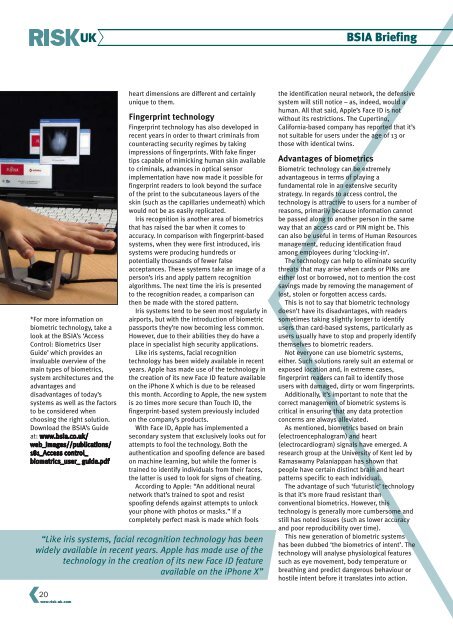RiskUKNovember2017
You also want an ePaper? Increase the reach of your titles
YUMPU automatically turns print PDFs into web optimized ePapers that Google loves.
BSIA Briefing<br />
*For more information on<br />
biometric technology, take a<br />
look at the BSIA’s ‘Access<br />
Control: Biometrics User<br />
Guide’ which provides an<br />
invaluable overview of the<br />
main types of biometrics,<br />
system architectures and the<br />
advantages and<br />
disadvantages of today’s<br />
systems as well as the factors<br />
to be considered when<br />
choosing the right solution.<br />
Download the BSIA’s Guide<br />
at: www.bsia.co.uk/<br />
web_images//publications/<br />
181_Access control_<br />
biometrics_user_ guide.pdf<br />
heart dimensions are different and certainly<br />
unique to them.<br />
Fingerprint technology<br />
Fingerprint technology has also developed in<br />
recent years in order to thwart criminals from<br />
counteracting security regimes by taking<br />
impressions of fingerprints. With fake finger<br />
tips capable of mimicking human skin available<br />
to criminals, advances in optical sensor<br />
implementation have now made it possible for<br />
fingerprint readers to look beyond the surface<br />
of the print to the subcutaneous layers of the<br />
skin (such as the capillaries underneath) which<br />
would not be as easily replicated.<br />
Iris recognition is another area of biometrics<br />
that has raised the bar when it comes to<br />
accuracy. In comparison with fingerprint-based<br />
systems, when they were first introduced, iris<br />
systems were producing hundreds or<br />
potentially thousands of fewer false<br />
acceptances. These systems take an image of a<br />
person’s iris and apply pattern recognition<br />
algorithms. The next time the iris is presented<br />
to the recognition reader, a comparison can<br />
then be made with the stored pattern.<br />
Iris systems tend to be seen most regularly in<br />
airports, but with the introduction of biometric<br />
passports they’re now becoming less common.<br />
However, due to their abilities they do have a<br />
place in specialist high security applications.<br />
Like iris systems, facial recognition<br />
technology has been widely available in recent<br />
years. Apple has made use of the technology in<br />
the creation of its new Face ID feature available<br />
on the iPhone X which is due to be released<br />
this month. According to Apple, the new system<br />
is 20 times more secure than Touch ID, the<br />
fingerprint-based system previously included<br />
on the company’s products.<br />
With Face ID, Apple has implemented a<br />
secondary system that exclusively looks out for<br />
attempts to fool the technology. Both the<br />
authentication and spoofing defence are based<br />
on machine learning, but while the former is<br />
trained to identify individuals from their faces,<br />
the latter is used to look for signs of cheating.<br />
According to Apple: “An additional neural<br />
network that’s trained to spot and resist<br />
spoofing defends against attempts to unlock<br />
your phone with photos or masks.” If a<br />
completely perfect mask is made which fools<br />
“Like iris systems, facial recognition technology has been<br />
widely available in recent years. Apple has made use of the<br />
technology in the creation of its new Face ID feature<br />
available on the iPhone X”<br />
the identification neural network, the defensive<br />
system will still notice – as, indeed, would a<br />
human. All that said, Apple’s Face ID is not<br />
without its restrictions. The Cupertino,<br />
California-based company has reported that it’s<br />
not suitable for users under the age of 13 or<br />
those with identical twins.<br />
Advantages of biometrics<br />
Biometric technology can be extremely<br />
advantageous in terms of playing a<br />
fundamental role in an extensive security<br />
strategy. In regards to access control, the<br />
technology is attractive to users for a number of<br />
reasons, primarily because information cannot<br />
be passed along to another person in the same<br />
way that an access card or PIN might be. This<br />
can also be useful in terms of Human Resources<br />
management, reducing identification fraud<br />
among employees during ‘clocking-in’.<br />
The technology can help to eliminate security<br />
threats that may arise when cards or PINs are<br />
either lost or borrowed, not to mention the cost<br />
savings made by removing the management of<br />
lost, stolen or forgotten access cards.<br />
This is not to say that biometric technology<br />
doesn’t have its disadvantages, with readers<br />
sometimes taking slightly longer to identify<br />
users than card-based systems, particularly as<br />
users usually have to stop and properly identify<br />
themselves to biometric readers.<br />
Not everyone can use biometric systems,<br />
either. Such solutions rarely suit an external or<br />
exposed location and, in extreme cases,<br />
fingerprint readers can fail to identify those<br />
users with damaged, dirty or worn fingerprints.<br />
Additionally, it’s important to note that the<br />
correct management of biometric systems is<br />
critical in ensuring that any data protection<br />
concerns are always alleviated.<br />
As mentioned, biometrics based on brain<br />
(electroencephalogram) and heart<br />
(electrocardiogram) signals have emerged. A<br />
research group at the University of Kent led by<br />
Ramaswamy Palaniappan has shown that<br />
people have certain distinct brain and heart<br />
patterns specific to each individual.<br />
The advantage of such ‘futuristic’ technology<br />
is that it’s more fraud resistant than<br />
conventional biometrics. However, this<br />
technology is generally more cumbersome and<br />
still has noted issues (such as lower accuracy<br />
and poor reproducibility over time).<br />
This new generation of biometric systems<br />
has been dubbed ‘the biometrics of intent’. The<br />
technology will analyse physiological features<br />
such as eye movement, body temperature or<br />
breathing and predict dangerous behaviour or<br />
hostile intent before it translates into action.<br />
20<br />
www.risk-uk.com

















